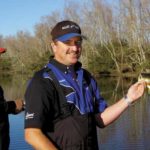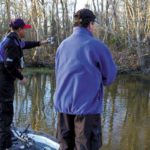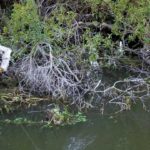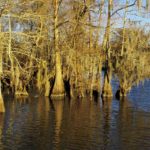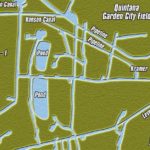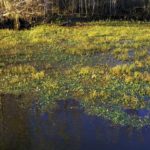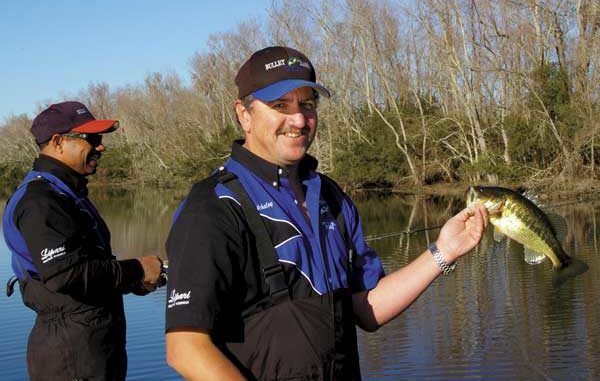
This destination in south-central Louisiana keeps bass anglers’ rods bent this time of year.
As a boy, perhaps, 7 or 8 years old, I used to sit with my elbows on the table with my face in my hands staring at the adults playing the board game “Scrabble.” One day, I was dubbed old enough to join the competitive fray and allowed to play. What’s more, I soon learned that if you were willing to take a risk by hanging onto the letter Q and parlaying it in some form of triple word score, you stood a big chance of winning.
Now, years later, if I were betting on catching some keeper bass, I’d once again hedge my bet on the letter Q — for Quintana.
Whether your goal is to win a bass tournament or to put a few fillets in the fryer, the canals that make up this region just might increase your score and odds of winning.
Lying south of Highway 90, west of Highway 317 and north of the Intracoastal Canal, the area is known by locals as simply “Quintana” for the name of the energy-production company that at one time operated the field.
However, most topographic maps read “Garden City Gas and Oil Field.” Quintana has stuck with those who work the field and with recreational anglers, though Burlington Resources is the operator today.
Patterson locals Gerald Foulcard and Ackaloy Paul are friends and tournament bass fishermen who frequent the area.
Foulcard, a supervisor for CLECO Power, and Paul, a grocer with Rouse’s, have fished Quintana for years.
“Quintana is fished by a lot of people, so it’s not like it’s a big secret,” Foulcard said while he, Paul and I fished the canals on a recent Sunday afternoon. “I’ve been fishing Quintana since I was a kid when my daddy used to take me out here. It’s also known for sac-a-lait too — they got some big sac-a-lait in here.”
Paul was introduced to the area by a friend.
“I learned the area from a guy who passed away named Willie Wise,” he said. “He used to make spinnerbaits, and I used them back here. I have only a few left that I very seldom use.
“Willie used to tell me I needed to broaden my horizons because I used to fish nothing but the Teche. He kinda messed up when he told me about Quintana — especially, when I started putting fish in the boat.”
Both Foulcard and Paul have their individual styles, likes and dislikes, but no matter how variable they are, the two have managed to compete, place and win tournaments fishing together since 1989.
“When we’re fishing a tournament together and we’re fishing Quintana, we go for our limit first and then we go look for our kicker fish,” Paul said. “The average fish will go 1 1/2 to 2 pounds, but there are plenty of big ones to weigh in.”
Foulcard agreed.
“What makes Quintana so good,” he said, “is it has clear water, a lot of grass and a lot of dead-end canals. In the early spring, when bass are staging, the water in the back of the canals is warmer.”
Foulcard proved the gradient difference by letting me know the temperature had risen from 47 degrees at the mouth of the canal to 50 degrees by the time we reached the back end.
“It also has flowing water because it’s tidally connected to the Intracoastal, and it has a lot of bait fish,” Paul added.
We worked toward the back of one canal tossing baits around logs, submerged stumps and myrtle branches, whose half-submerged limbs formed cover that predator fish hold to. It wasn’t long before Foulcard heaved on his pole with lip-ripping force. But it was a swing and a miss.
“I don’t want you expending all that energy now,” Paul chided. “You know I’m giving you some time to get a lead first.”
“He’s trying to make me fish hard,” Foucard said. “We do that to each other.”
“Well at least he didn’t hook me this time,” Paul said.
As the story goes, the two fished a Top-6 Club Tournament at Toledo Bend several years before, where Foulcard hooked his partner in the shoulder the first day.
“Here I was with a bait in my shoulder, and he kept saying, ‘What about my bait?’ He was worried about his bait because he was catching fish on it. It was a Zara Spook bait,” Paul recounted.
“I was catching fish on it,” Foulcard said. “I wanted to throw him in with it!”
Don’t let this odd couple fool you; they know and throw baits as effectively as anyone, and demonstrated by using a variety of baits that have proven effective in Quintana.
“One of my favorites back here is a 3/8-ounce watermelon/red bait called Yo Moma by Big Bite with a 1/0 big gap hook,” Paul said. “During this time of year, crawfish are starting to come out, and their young are going to be a greenish red.”
Foulcard likes to use spinnerbaits that he assembles himself.
“I buy a gold chopper blade and put it together with a 3/8-ounce chartreuse jig head set at 90 degrees on a .030 wire with a white skirt,” he said. “I like using it in clear water when there’s a bit of overcast or when it’s partly cloudy to sunny.”
“I guess that’s what makes me and Gerald good teammates,” Paul said. “We’re different. We’ll sit there and talk to each other about what’s working and try to find a pattern. If we’re fishing a tournament together, we’ll fish against each other to push each other and try different tactics.”
Paul likes to flip jigs in Quintana, and according to the two anglers, they approach the area in much the same way as they do Stephensville. In an area they refer to as the Stump Canal, both banks are lined with cypress trees. The numerous submerged stumps you cannot see make flipping a jig an effective tactic.
I was amazed at how Paul flipped and tossed jigs with precision into an area smaller than a quadrat. He split areas so small, I just knew his $4 bait was gone, only to watch him work it out.
Paul told the story of how he got started flipping.
“I used to go fishing years ago with a local guy named Dan Erwin,” he said. “Dan would always be using a flipping stick, and beat me fishing—- bad! One time we were scouting this area where we were going to fish about two weeks before a tournament. He wouldn’t even let me use one of his flipping poles. So I went and bought me a rod at Wal-Mart to flip with. It was a big, stiff, telescopic saltwater rod. I had a baitcast reel for it.
“I practiced tossing and flipping a jig until I could flip it in a 5-gallon bucket, getting used to it. Come tournament day, I pulled the rig out and started catching fish with it. (Erwin) didn’t want me to have one. I beat him in his own boat — from the back of his boat. Did he ever laugh at me. But I caught fish with it and beat him.”
In the back of a couple of dead-end canals were marshy bogs, also known as a quag. These marshy areas along the back edge of the canals are where the aquatic vegetation forms grass mats on top of the shallow water. The mats are ideal for punching through or working a frog over as bass lurk below.
“Those mats do a couple of things,” Foulcard explained. “The sun warms the grass, and bass hang out underneath it during the winter and spring. But it also acts as shade during the hot summer. There are fish under there.”
Foulcard doesn’t avoid the fact that he is a spinnerbait and crankbait man, but he does use plastics. When he changed up after probing and not having any luck with his homemade chartreuse/white spinnerbait, he began to get bites with plastics, landing our first fish of the afternoon.
“When using plastics, it’s slower fishing, and I like to be doing something,” Foulcard said. “But I’ll use a lizard, a 5-inch worm and baits that resemble crawfish in Quintana. These fish today are acting finicky. They aren’t hitting the bait hard. They’re just picking it up like when they move something off the nest when they spawn.”
It wasn’t long before Paul nailed a fish with a follow-up cast where Foulcard had just thrown.
Foulcard feigned an incredulous look.
“You see that? He threw his bait right where I just had a strike,” he said.
“I cheap-shot him — that’s why I bring him along,” Paul picked back.
For these two anglers, bass are the main attraction in the area, but the canals and waterways also teem with sac-a-lait.
“I used to fish sac-a-lait a lot, but bass fishing is so addictive and it’s so hard for me to switch over,” Foulcard said. “If I had my mind made up to come do that, I’d have to leave everything at home. A lot of people use shiners and tube jigs in here. I like to use black/blue, black/yellow or white/blue tubes when I fish them.”
Paul’s partial to another color combination.
“Back here, black/pink works well too,” he said. “Gerald and I caught so many sac-a-lait with black/pink that it made me a believer.”
If you’re on a quest for an area that will provide you with winning quantities of quality bass that break the water quavering side to side to throw your bait, try Q for Quintana.
